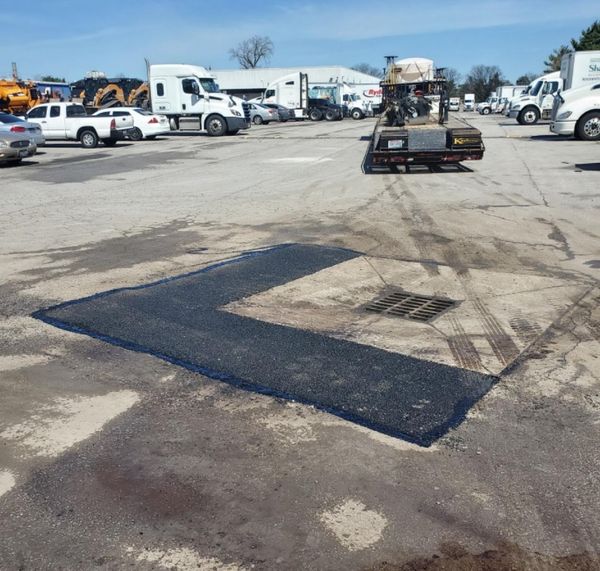%201%20(1).webp)
%201%20(1).webp)

The Importance of Quality Pavement Maintenance


How to Identify and Address Concrete Spalling in Columbus Installations
Concrete surfaces in Columbus take on a lot throughout the seasons. Between temperature swings, freeze-thaw cycles, and everyday use, it’s not unusual for wear and tear to show up. One of the more common and frustrating issues is spalling. This refers to when the surface of the concrete begins to flake, chip, or break apart. What starts as a small eyesore can quickly become a bigger problem, especially if left untreated.
Understanding this issue early can help homeowners avoid expensive repairs. Whether it’s your driveway, patio, or walkway, ignoring the early signs could lead to bigger damage. Concrete installation in Columbus needs to be monitored closely in order to stay strong and functional for years. Taking action at the first signs of spalling can protect your property and keep it safe.
Understanding Concrete Spalling
Concrete spalling happens when small pieces of the surface layer start to separate from the rest of the slab. It can look like flakes peeling off or chunks breaking away, and it usually starts on the top few inches of poured concrete. While it may seem like a cosmetic problem at first, spalling can signal deeper structural concerns if ignored.
In Columbus, common causes of concrete spalling include:
- Freeze-thaw cycles: When water gets into the concrete and freezes, it expands. This causes pressure inside the material, eventually making the surface crack and flake.
- Poor finishing: If the concrete was not finished properly when it was installed, it can lead to surface weakness.
- Deicing salts: Using certain salts in the winter to melt snow and ice can wear away the surface.
- Low-quality materials: When the concrete mix is not properly balanced, it can weaken overall durability.
- Moisture infiltration: Water settling into joints, cracks, or porous surfaces without drainage or sealing can lead to damage over time.
Homeowners in Columbus often notice spalling first by seeing patches where the texture of the surface looks different than the rest. It may look rough, pitted, or uneven. Discoloration can also appear before the surface begins to flake or chip away. If someone walks across the area and notices crumbling or softness underfoot, that is another strong sign the concrete may be breaking down underneath. For example, one homeowner in the Clintonville area reported seeing thin chips collecting near the garage entrance. At first it just seemed like dust or dirt, but eventually larger chunks began falling away, exposing the aggregate beneath.
Recognizing these early symptoms is the key to taking effective action before the damage spreads deeper or becomes more widespread. Once spalling starts, it tends to follow joints and edges, moving across the slab quickly when untreated.
Steps to Identify Spalling Issues
It is important for homeowners to regularly inspect their concrete installations before small issues turn into large repairs. Recognizing spalling early begins with a few easy steps:
1. Walk through and check regularly: Set aside time every couple of months to look over the concrete around your home. Pay close attention to areas near doors, in high-traffic spots like driveways, and anywhere water tends to collect.
2. Look for signs of surface changes:
- Rough or gritty surface texture in patches
- Flaking or chipping areas, especially near joints
- Exposed aggregate (small stones becoming visible)
- Discoloration or uneven coloring of surface
3. Tap-test with a tool: Gently tapping suspected areas with a small hammer can help detect deeper flaws. Hollow sounds may indicate delamination just below surface level.
4. Check for soft spots: Press down with your foot or hand. If the surface feels softer or gives slightly, spalling may be beginning underneath.
5. Keep an eye on drainage: Look for standing water near concrete edges or surfaces. Poor drainage often leads to moisture getting inside and triggering spalling.
Taking these simple steps can help stay ahead of damage and reduce the likelihood of dealing with a bigger issue wherever there is concrete installation in Columbus. It may not seem urgent at the time, but catching something early could mean the difference between a quick repair and a total replacement. Keeping just half an hour each season to check can really pay off.
Effective Methods to Address Concrete Spalling
Once signs of spalling are confirmed, the next step is deciding how to deal with the damage in a way that prevents it from worsening. In most cases, surface-level patches do not offer long-term results. A proper solution requires a full evaluation to understand what has triggered the damage and how far it has spread. This is where having trained professionals step in can make the difference.
To get spalling under control and help your concrete surfaces last longer, here are a few of the most reliable repair approaches:
- Inspection and assessment: The first step is always a complete inspection. Our professionals can check how much spalling has occurred, what might be causing it, and whether the damage is limited to the surface or affecting deeper layers.
- Surface resurfacing: If the issue is mostly surface-level, resurfacing the concrete often restores the area. This involves applying a new topcoat of material to bond over the damaged surface. It gives the slab a fresh look and improves durability.
- Crack and chip repair: For isolated cracks or small patches of spalling, targeted repair with bonding agents and patching compounds can provide solid, blended fixes. These solutions help prevent further erosion around the damaged areas.
- Sealing and waterproofing: After repairs are complete, applying a sealant helps shield the surface from water, salt, and other factors that weaken concrete over time.
- Drainage corrections: If poor drainage is contributing to moisture buildup, adjustments may be needed around the area. This might involve regrading or adding features like drains or edging.
These methods, done correctly, restore function while helping keep up appearances. Especially for visible concrete installations around the home, like driveways and patios, unfinished repairs can stand out in a way that is hard to ignore. Timely professional help prevents further breakdown and avoids higher replacement costs later on.
Maintenance Tips for Concrete Installation in Columbus
Once repairs are made, keeping the surface in good shape takes some attention. Preventive maintenance does not have to be complicated. Small steps throughout the year can help extend the service life of concrete installations in Columbus. Pay attention to areas that face the most exposure, such as near downspouts, entryways, and heavily shaded corners where moisture might collect.
Key maintenance tasks include:
- Regular cleaning: Wash grime away with mild soaps and water pressure, especially after winter weather or storm activity.
- Seasonal inspections: Look for signs of wear around late spring and again in early fall. This helps spot potential issues before they worsen.
- Sealing every few years: Sealing shields your surface from rain, salt, and temperature damage. Sealing schedules depend on traffic and exposure, but applying sealant at the right interval prevents early aging.
- Remove snow carefully: During colder months, avoid metal blades that scrape the concrete, and skip the harsh deicers. Use safe alternatives that will not chip the surface.
- Avoid pooling water: Make sure downspouts direct water away from concrete areas. Consider using extensions or splash blocks if needed.
- Keep plants trimmed nearby: Roots or excess moisture from shrubs or grass along edges can create weak spots or hold water against the surface.
Concrete does not require constant upkeep, but it does respond better with a little attention now and then. It is easier to keep a surface strong than to recover from deep damage or deterioration. A well-kept concrete slab will hold its structure better and maintain curb appeal longer.
Ensuring Longevity for Your Concrete Surfaces
Taking action early against concrete spalling can save time, money, and frustration. Spalling might begin with a small blemish, but delays often push the damage deeper and make outcomes harder to fix. Understanding how the issue begins and how to spot early symptoms helps homeowners act before the problem spreads or affects safety.
Regular inspection, timely repair, and preventive maintenance are the three biggest factors in keeping your concrete installations strong and looking their best throughout the years. Being proactive with repairs keeps small cracks from growing and gives you peace of mind about the stability of your surfaces. Whether it is a minor patch or a resurfacing need, getting help from trained professionals ensures repairs are done the correct way.
For homeowners in Columbus, especially during summer, these steps can help avoid weather-related problems like moisture buildup and sun exposure. Keeping a clean, sealed, and damage-free surface also helps protect nearby landscaping and walkways. These factors all play into making sure you are getting good long-term value out of your concrete investment.
If you notice signs of damage on your concrete surfaces, taking action now can prevent further deterioration and ensure lasting performance. Our professionals recommend evaluating your concrete installation in Columbus to determine the best repair strategy while maintaining curb appeal. Professional Pavement Services is here to help protect your property with proven solutions tailored to your needs. For a quick estimate or to book a service visit, please contact us today.
Recent Posts

Join Our Community of Readers
Stay updated with our latest insights and share your thoughts with us in the comments!


.svg)












.png)




